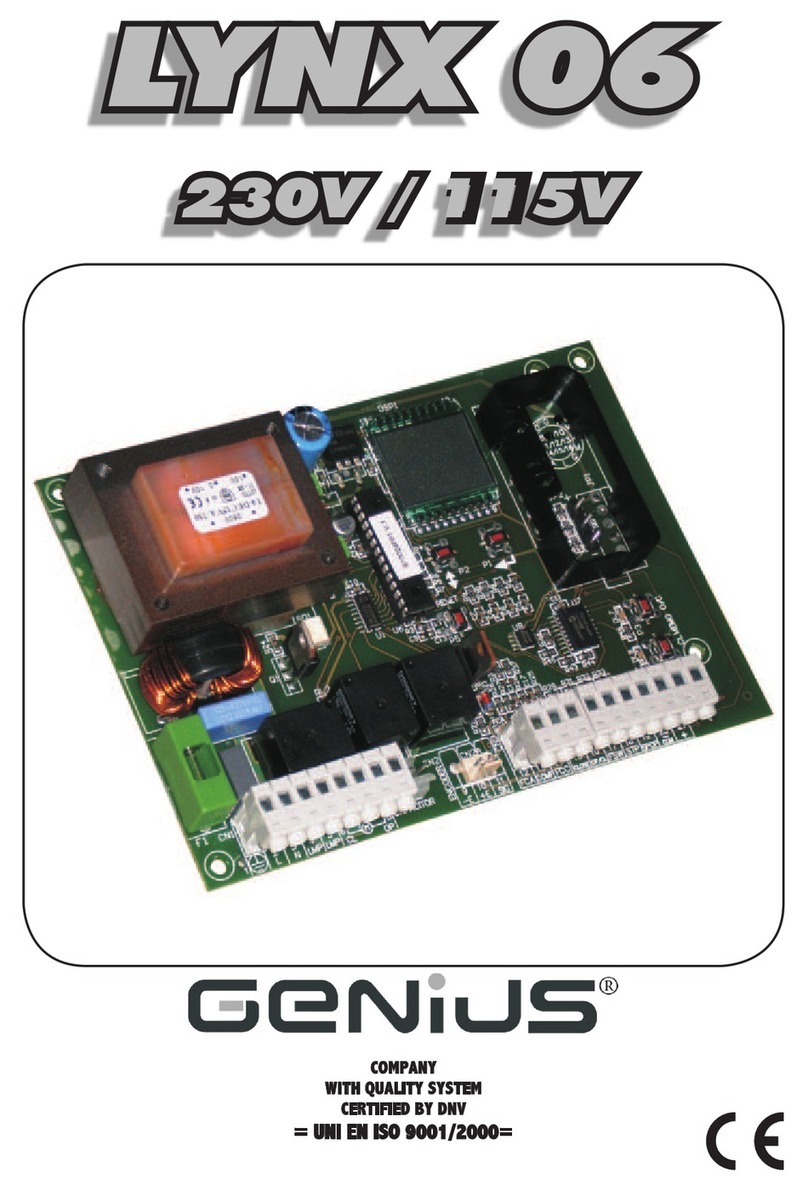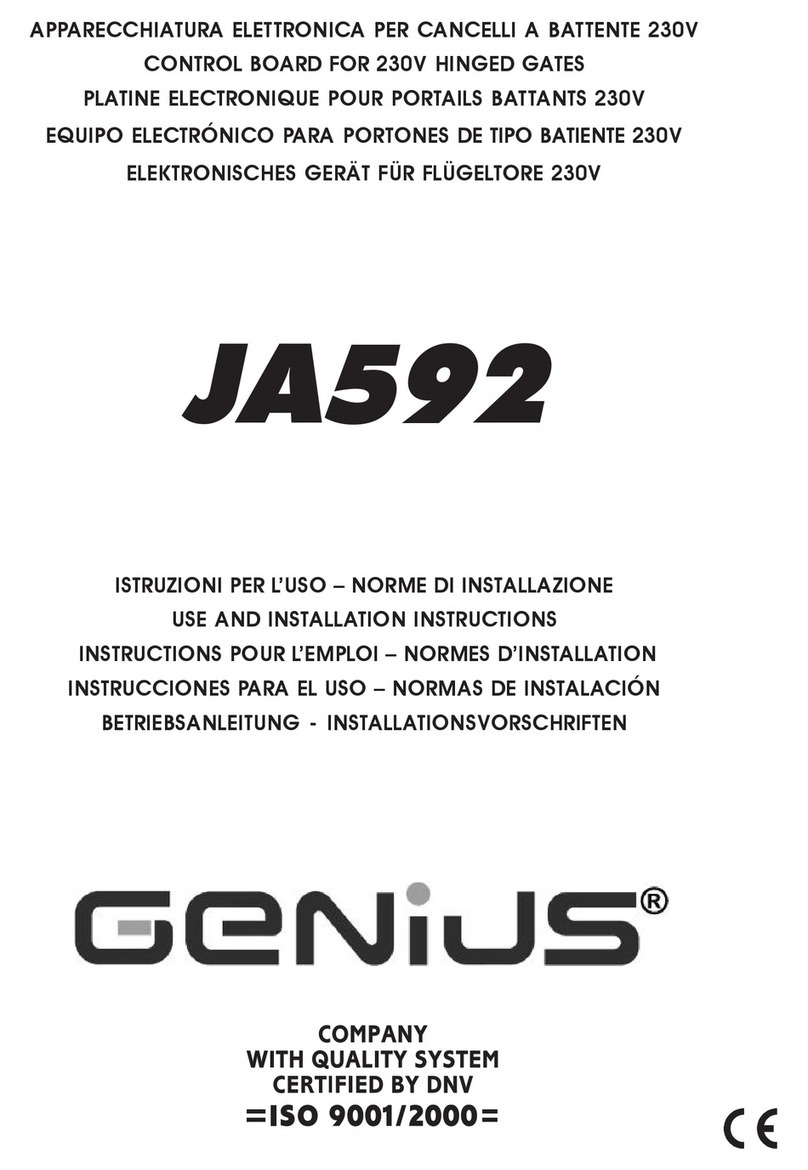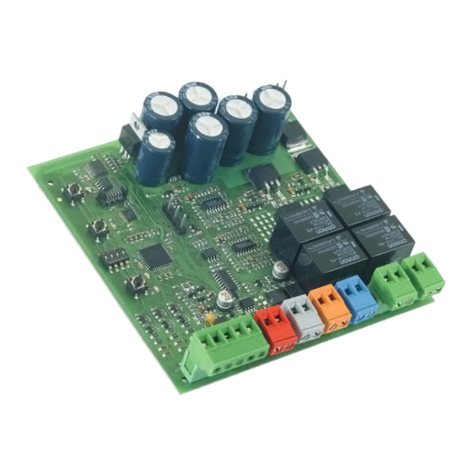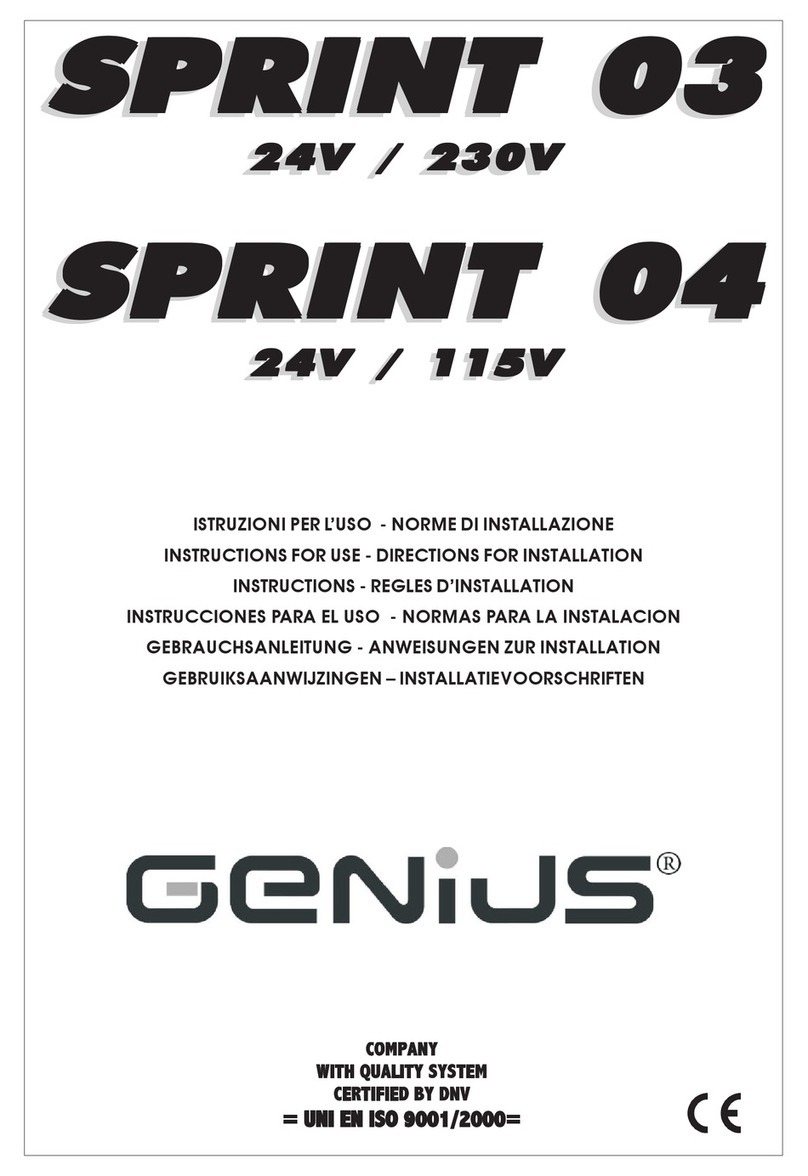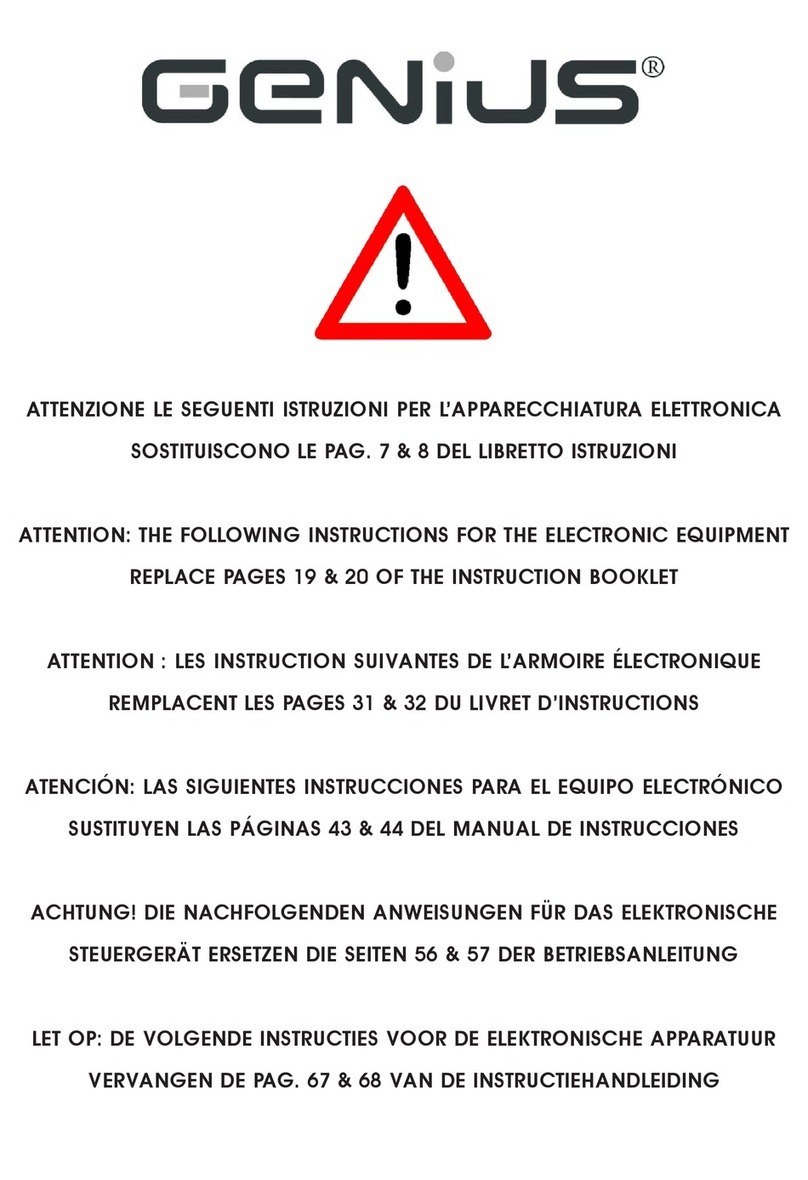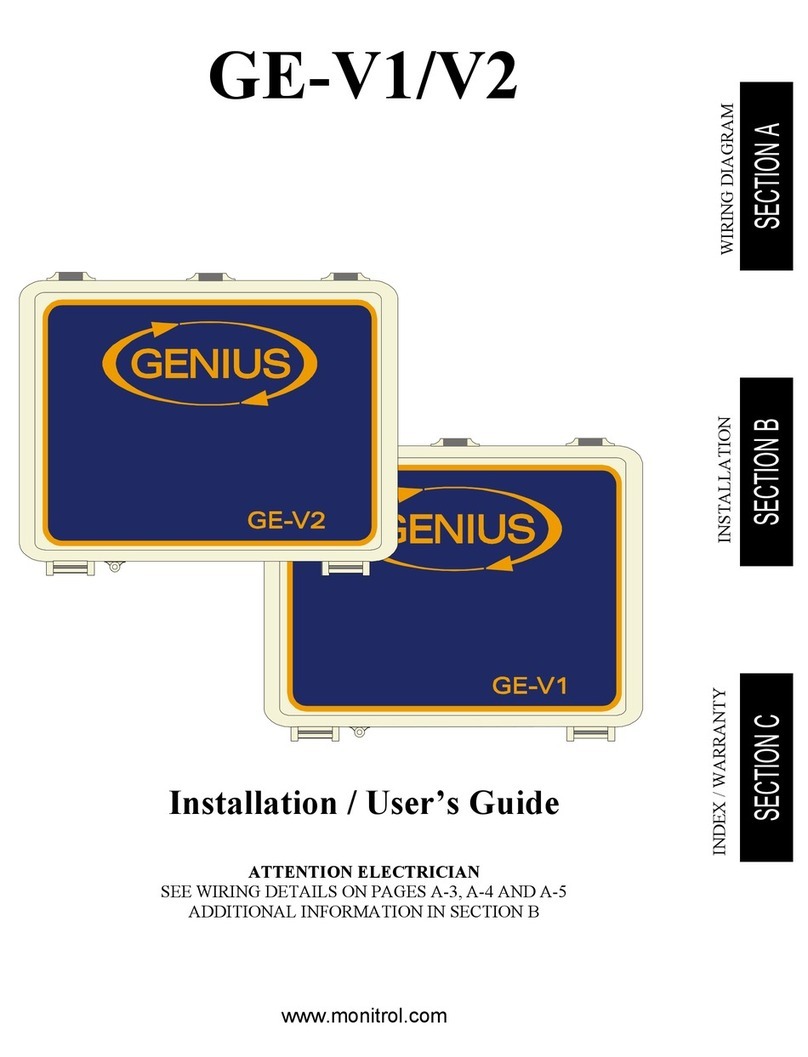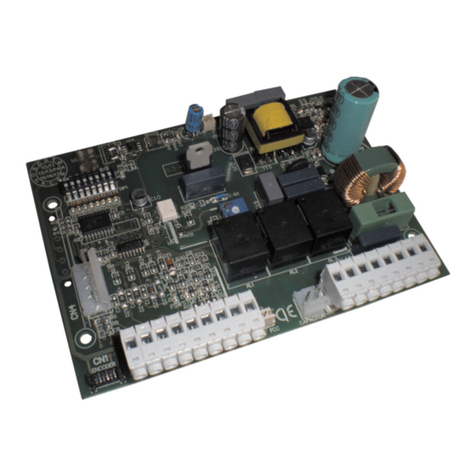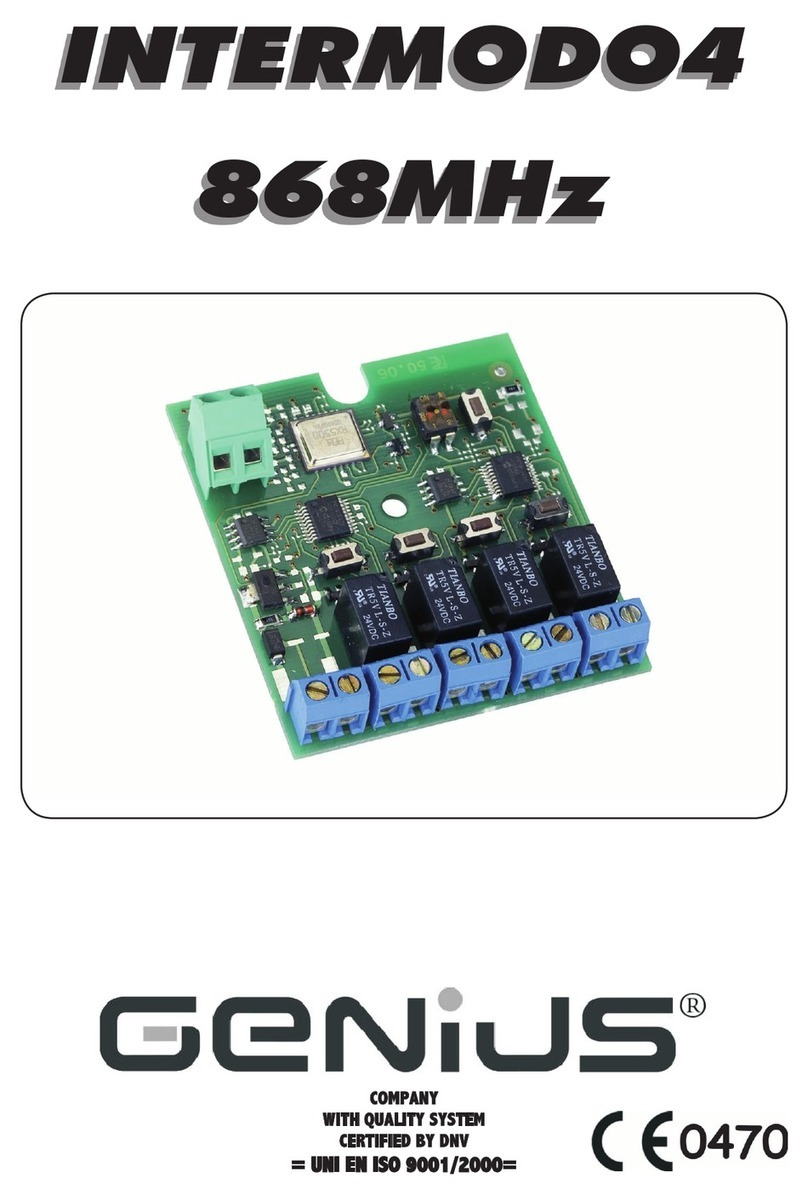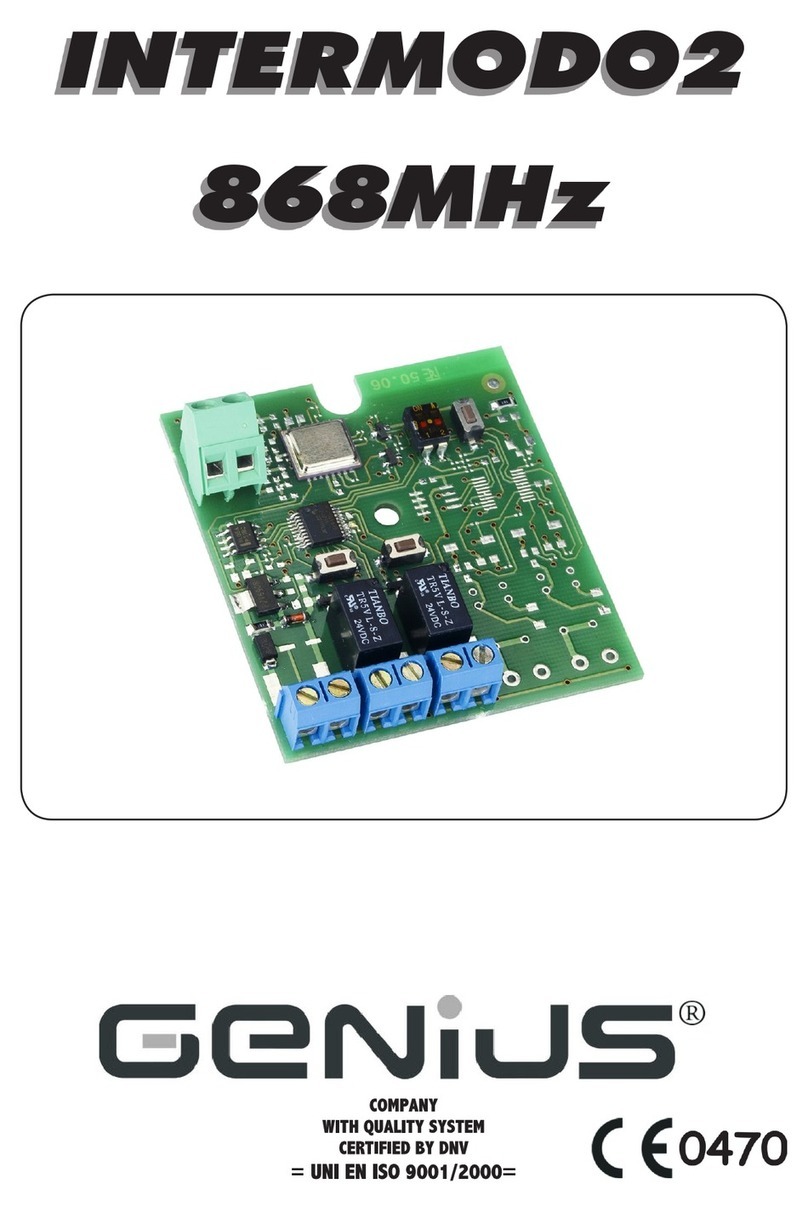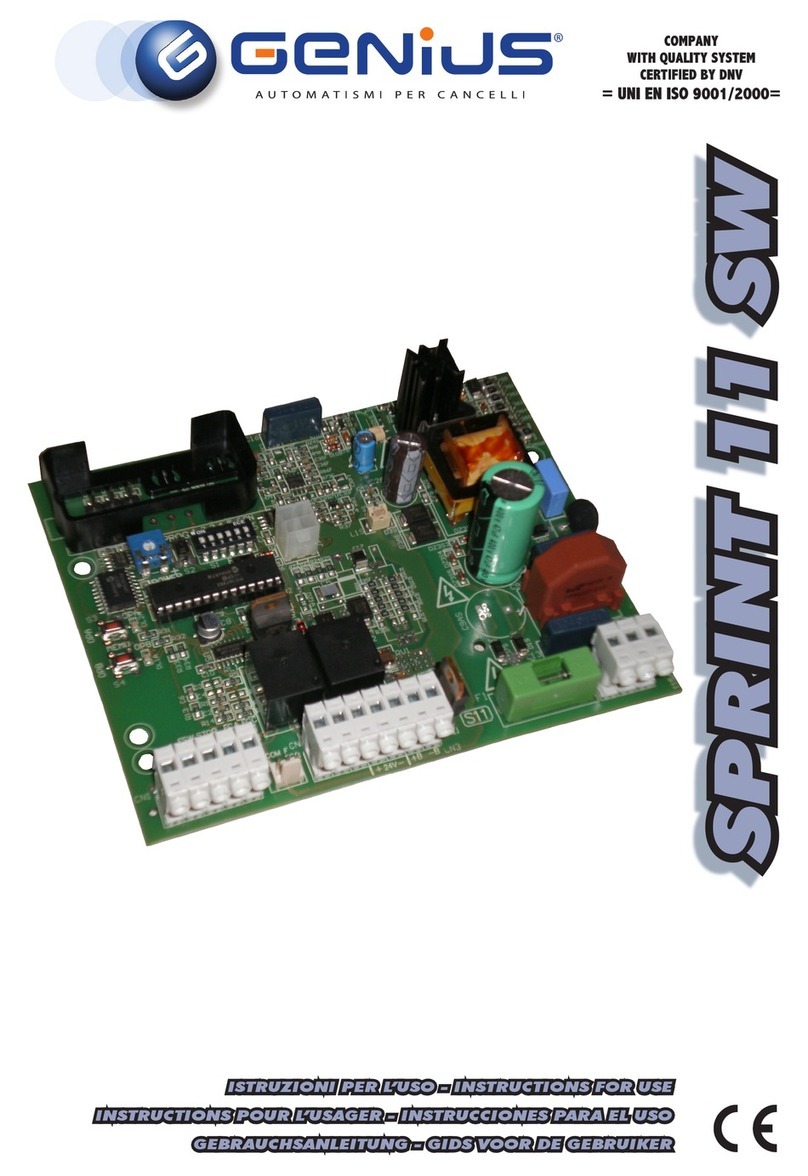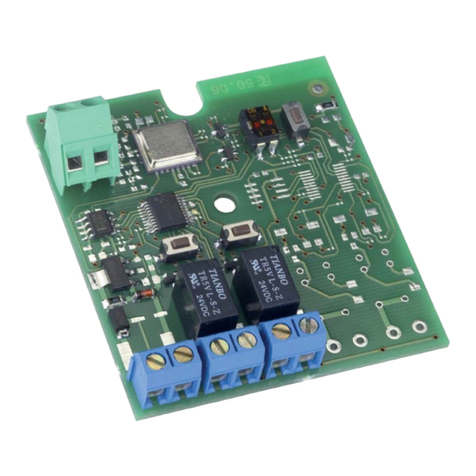
AVVERTENZEPERL’INSTALLATORE
OBBLIGHI GENERALI PER LA SICUREZZA
1) ATTENZIONE! È importante per la sicurezza delle persone seguire attenta-
mentetuttal’istruzione.Unaerratainstallazioneounerratousodelprodotto
può portare a gravi danni alle persone.
2) Leggere attentamente le istruzioniprimadiiniziarel’installazionedelprodot-
to.
3) I materiali dell’imballaggio (plastica, polistirolo, ecc.) non devono essere
lasciatiallaportatadeibambiniinquanto potenziali fonti di pericolo.
4) Conservare le istruzioni per riferimenti futuri.
5) Questo prodotto è stato progettato e costruito esclusivamente perl’utilizzo
indicatoin questadocumentazione. Qualsiasialtro utilizzononespressamen-
teindicato potrebbe pregiudicare l’integrità del prodotto e/o rappresen-
tare fonte di pericolo.
6) GENIUS declina qualsiasiresponsabilitàderivata dall’uso improprioo diverso
daquello per cui l’automatismo è destinato.
7) Noninstallare l’apparecchioinatmosfera esplosiva:la presenzadigas ofumi
infiammabilicostituisceungravepericoloperla sicurezza.
8) Gli elementi costruttivi meccanici devono essere in accordo con quanto
stabilito dalle Norme EN 12604 e EN 12605.
PeriPaesi extra-CEE, oltre ai riferimenti normativi nazionali, per ottenere un
livellodi sicurezza adeguato, devono essereseguitele Norme sopra riporta-
te.
9) GENIUS non è responsabile dell’inosservanza della BuonaTecnicanellaco-
struzione delle chiusure da motorizzare, nonché delle deformazioni che
dovesserointervenire nell’utilizzo.
10) L’installazionedeveessereeffettuata nell’osservanza delle NormeEN12453
eEN 12445. Il livello di sicurezza dell’automazione deve essere C+E.
11) Prima dieffettuarequalsiasi interventosull’impianto,togliere l’alimentazione
elettrica.
12) Prevedere sulla rete di alimentazione dell’automazione un interruttore
onnipolarecon distanza d’apertura dei contattiugualeo superiore a 3mm.
Èconsigliabilel’usodiunmagnetotermicoda6Aconinterruzioneonnipolare.
13) Verificare che a monte dell’impianto vi sia un interruttore differenzialecon
sogliada0,03A.
14) Verificare che l’impianto di terra sia realizzato a regola d’arte e collegarvi
lepartimetalliche della chiusura.
15) L’automazionedisponediuna sicurezza intrinseca antischiacciamento co-
stituitada uncontrollodi coppia. E'comunquenecessario verificarnelasogli
diinterventosecondo quanto previsto dalle Norme indicate al punto 10.
16) I dispositivi di sicurezza (norma EN 12978)permettono diproteggere even-
tuali aree di pericolo da Rischi meccanici di movimento, come ad Es.
schiacciamento,convogliamento,cesoiamento.
17) Perogniimpiantoè consigliato l’utilizzodialmeno una segnalazione lumino-
sanonché diun cartellodisegnalazione fissatoadeguatamentesulla struttu-
radell’infisso, oltre ai dispositivi citati al punto “16”.
18) GENIUSdeclinaogniresponsabilità aifinidella sicurezzaedel buon funziona-
mentodell’automazione, incaso venganoutilizzati componentidell’impian-
tonon di produzione GENIUS.
19) Perlamanutenzioneutilizzareesclusivamente parti originali GENIUS.
20) Non eseguire alcuna modifica sui componenti facenti parte del sistema
d’automazione.
21) L’installatore deve fornire tutte le informazioni relative al funzionamento
manuale del sistema in caso di emergenza e consegnare all’Utente
utilizzatoredell’impiantoil libretto d’avvertenze allegato al prodotto.
22) Nonpermettereaibambini o personedi sostare nellevicinanzedel prodotto
duranteil funzionamento.
23) Tenerefuoridallaportata deibambiniradiocomandi o qualsiasialtrodatore
diimpulso, per evitare che l’automazione possa essere azionata involonta-
riamente.
24) Iltransitotrale ante deve avvenire solo acancellocompletamenteaperto.
25) L’Utente utilizzatore deve astenersi da qualsiasi tentativo di riparazione o
d’interventodirettoerivolgersi solo a personale qualificato.
26) Tutto quello che non è previsto espressamente in queste istruzioni non è
permesso
IMPORTANT NOTICE FOR THE INSTALLER
GENERAL SAFETY REGULATIONS
1) ATTENTION! To ensure the safety of people, it is important that you read
all the following instructions. Incorrect installation or incorrect use of the
product could cause serious harm to people.
2) Carefully read the instructions before beginning toinstalltheproduct.
3) Do not leave packingmaterials (plastic, polystyrene, etc.) within reach of
childrenas such materials are potential sources of danger.
4) Storetheseinstructionsfor future reference.
5) This product was designed and built strictly for the use indicated in this
documentation.Any otheruse,not expressly indicatedhere, could compro-
mise the good condition/operation of the product and/or be a source of
danger.
6) GENIUS declines all liabilitycausedbyimproper use or useotherthan that for
whichthe automatedsystem wasintended.
7) Do not install the equipment in an explosive atmosphere: the presence of
inflammablegas or fumes is a serious danger tosafety.
8) The mechanical parts must conform to the provisionsofStandardsEN12604
andEN 12605.
For non-EU countries, to obtain an adequate level of safety, the Standards
mentionedabovemustbeobserved, inaddition tonational legalregulations.
9) GENIUS is not responsible for failure to observe Good Technique in the
constructionof the closingelementsto be motorised, orforany deformation
thatmay occur duringuse.
10) Theinstallationmustconform toStandardsEN 12453andEN 12445.Thesafety
levelof the automated system mustbeC+E.
11) Before attempting any job on the system, cut out electrical power.
12) Themains power supply of the automated systemmustbefittedwithan all-
pole switch with contact opening distance of 3mm or greater. Use of a 6A
thermalbreakerwith all-pole circuit break is recommended.
13) Makesurethata differential switch with threshold of 0.03Aisfitted upstream
ofthe system.
14) Make sure that the earthing system is perfectly constructed, and connect
metalparts of the means of the closure to it.
15) The automatedsystem is suppliedwith anintrinsicanti-crushing safetydevice
consisting of a torque control. Nevertheless, its tripping threshold must be
checkedas specified in the Standards indicated at point 10.
16) The safety devices (EN 12978 standard) protect any danger areas against
mechanicalmovement Risks,suchas crushing, dragging,and shearing.
17) Use of at least one indicator-light is recommended for every system, as well
asawarningsignadequately secured to the frame structure, in addition to
thedevices mentioned at point “16”.
18) GENIUSdeclinesallliability as concerns safety and efficientoperationof the
automatedsystem,ifsystem componentsnot producedby GENIUSareused.
19) Formaintenance,strictlyuse original parts by GENIUS.
20) Donotinany way modify the componentsofthe automated system.
21) Theinstallershallsupply all information concerning manual operationofthe
systemin caseof anemergency,and shallhandover tothe user thewarnings
handbooksupplied withtheproduct.
22) Do not allow children or adults to stay near the product while it is operating.
23) Keep remote controls or other pulse generators away from children, to
preventthe automated system frombeingactivatedinvoluntarily.
24) Transitthroughtheleaves is allowed only when the gate is fully open.
25) The user must not attempt any kindof repairor directaction whatever and
contactqualified personnel only.
26) Anything not expressly specified in these instructions is not permitted.
CONSIGNES POUR L'INSTALLATEUR
RÈGLES DE SÉCURITÉ
1) ATTENTION! Il est important, pour la sécurité des personnes, de suivre à la
lettre toutes les instructions. Une installation erronée ou un usage erroné
du produit peut entraîner de graves conséquences pour les personnes.
2) Lire attentivement les instructions avant d'installer le produit.
3) Lesmatériaux d'emballage(matièreplastique, polystyrène,etc.)ne doivent
pas être laissés à la portée des enfants car ils constituent des sources
potentiellesde danger.
4) Conserver les instructions pour lesréférencesfutures.
5) Ce produit aétéconçu et construitexclusivement pour l'usageindiquédans
cette documentation. Toute autre utilisation non expressément indiquée
pourraitcompromettre l'intégrité du produit et/ou représenter une source
dedanger.
6) GENIUS décline toute responsabilité qui dériverait d'usage impropre ou
différentde celui auquel l'automatisme est destiné.
7) Ne pas installer l'appareil dans une atmosphère explosive: la présence de
gazou de fumées inflammablesconstitueungrave danger pour lasécurité.
8) Lescomposants mécaniquesdoivent répondreaux prescriptionsdes Normes
EN 12604 et EN 12605.
Pourles Pays extra-CEE, l'obtention d'un niveau desécuritéapproprié exige
nonseulement le respectdes normes nationales,maiségalement le respect
desNormessusmentionnées.
9) GENIUSn'est pasresponsabledu non-respectdela BonneTechniquedans la
constructiondes fermetures à motoriser, ni des déformations qui pourraient
intervenirlorsde l'utilisation.
10) L'installationdoitêtreeffectuée conformément aux Normes EN 12453 et EN
12445.Leniveaude sécurité de l'automatisme doit être C+E.
11) Couperl'alimentationélectriqueavant toute intervention sur l'installation.
12) Prévoir, sur le secteur d'alimentation de l'automatisme, un interrupteur
omnipolaireavecune distanced'ouverturedescontactségale ousupérieure
à 3 mm. On recommande d'utiliser un magnétothermique de 6A avec
interruptionomnipolaire.
13) Vérifierqu'ilyait,enamont de l'installation, un interrupteur différentiel avec
unseuilde 0,03 A.
14) Vérifier que la mise à terre est réalisée selon les règles de l'art et y connecter
lespiècesmétalliques de la fermeture.
15) L'automatismedisposed'unesécurité intrinsèque anti-écrasement, formée
d'un contrôle du couple. Il est toutefois nécessaire d'en vérifier le seuil
d'interventionsuivant les prescriptions des Normes indiquéesaupoint 10.
16) Les dispositifs de sécurité (norme EN 12978) permettent de protéger des
zones éventuellement dangereuses contre les Risques mécaniques du
mouvement,commel'écrasement,l'acheminement, le cisaillement.
